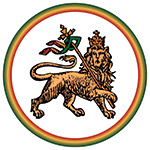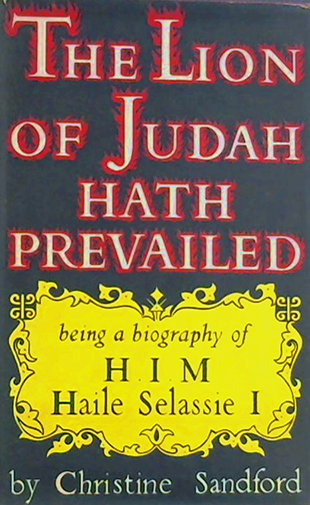THE LION OF JUDAH HATH PREVAILED
20
Silver Jubilee
The years 1920—1930—1940—1955! Let us look at these milestones on the road to Silver Jubilee.
1920. Four years after the revolution which had put Ras Tafari at the head of the reform party, with Menelek’s daughter on the throne, and the old Fitaurari holding the scales.
The only way to reach Addis Ababa was to come up by the train from Djibuti, spending three days on the journey, for it was not considered safe to travel by night The Danakil tribes found the lengths of railway line convenient for melting down and beating into spearheads, and a night raid might remove a few hundred yards. About 4.30 the train would toil wearily into the station—nothing but a collection of tin-roofed huts along the line. There all the foreign population would be gathered—for there was not much other distraction in Addis Ababa of 1920—and the station was quite a pleasant afternoon ride through the fields and lanes, to rendezvous with old friends and meet new ones.
Three curious conveyances awaited us: an elegant victoria with a lace frilled hood, and a couple of traps for the luggage. We cantered up the steep mud slope that led to the centre of the town with a mounted retinue of friends and acquaintances alongside. We passed through the gates set where the road narrows at the top of modern Churchill Road, past the old post office and the few, very few, shops, out of the gates again that marked the eastern edge of the town, where the State Bank now stands, and away over the Makonnen bridge, with no protecting rail and half its present width. So out we went into the lanes and mud track that led across the Kabana—not by the English bridge, for that was a pile of odd masonry with a four-foot drop the other side—but a road wound round past the gates of the German Legation and over a narrow bridge that led up to the old Imperial Russian Legation that was to be our home.
The very next day on that narrow bridge we came face to face with the only car in Addis Ababa. It had been a gift from the Italians to the Empress Zauditu and was used perhaps once or twice a year. Both ponies reared and the back wheel went over the edge.
But it was pushed on again and we continued our journey to the open polo ground and racecourse—that wonderful spread of open meadow land, unfenced and open to all, which lay between the little ghibbi and the Kabana river. There was no new palace, for Ras Tafari lived, as did most people in those days, in a modest house of wattle and daub with a tin roof, and a long veranda where his visitors waited admittance.
A long narrow audience chamber, raised at one end, with fine rugs and a row of straight-backed chairs on either side, opened out of a small antechamber; their Highnesses sat on two gilt chairs facing down the room, and there were often a pair of young lion cubs playing about our ankles.
Every day the Regent rode down from his house to the big ghibbi which Menelek had built, where the Empress had her audience chamber in the little three-storeyed building that still stands over the main entrance. He would be accompanied by several hundred men-at-arms of his personal retinue—the bodyguard to be—the soldiers in their narrow white trousers and long shirts with the loin-cloth wound tight round and round their waists, and their rifles over their shoulders.
Just as in his early provincial days, anyone with a petition or a grievance might stand on the road with a stone or a pole on his shoulder and solicit attention; the Ras would nod to an attendant to find out the matter and bring it later to his notice. Sometimes a group would be sitting there uttering in unison the cry ‘Abet! Abet!’ and prostrating themselves as he passed. The appeal was always heard.
No cars, no conveyances of any kind apart from two or three dog-carts maintained by the legations, but seldom used, for we rode out to lunch, to tennis, to dinner with a hurricane lamp swinging—or once in Harar with torches carried flaming alongside us to dine with Ras Imeru, back again in Harar as Governor in 1924—to receptions at the ghibbi, often lasting from ten to four, to church service next to the Bololakos hotel. Immense courtesy everywhere— friendly faces, and shy but smiling children. A paperchase through the outskirts of the town once drew a horde of rushing helpers, eager, even to the extent of using their rifles, to help us catch the thieves. No police by day but a few night watchmen about the streets to call out ‘Who’s there?’ and be content with the answer ‘It is I.’
The presentation of credentials was a picturesque affair— a richly decked mule was provided by the Empress and sent with an army some thousand strong to the legation. Mounted on this in his uniform and plumed hat the Minister rode followed by his staff—in a variety of formal attire, even to frock coat and top hat—on their ponies. The procession rode impressively among the eucalyptus-trees that fringed the road.
Along the same road I saw the army pass the following year when the Regent, who had left the town a few days previously, brought in the prisoner Lij Yasu after his five years’ wandering among the Danakil. They were a motley crowd, rejoicing as they came along, the chiefs in their finery, striped silk shirt, cloak, and lion’s mane circlet.
1930. These are pictures of the past. Then the Regent became Emperor.
The old city gates were removed, the centre of the town cleared up and laid out, and here and there stone buildings began to rear their two or three storeys alongside the wattle and daub houses and tin huts, and open booths which had constituted the shops of Addis Ababa. It was impossible to buy even a safety pin in 1920; now there were dresses, nouveautes from Paris, knitting wool, even books and photographic materials.
Roads inside the capital were cleaned, widened, and metalled, so that by 1930 it was possible for anyone who had the fare to take a taxi from one end of the town to the other. The Emperor had his Rolls-Royce as well as another car—he once in kindness sent a small caterpillar pick-up so that my family might, over rough roads, reach his children’s Christmas party in safety.
Public executions were abolished and the old tree of execution outside St George’s Cathedral cut down and replaced by a fine statue of Menelek and a public garden. It was unveiled in the presence of the Duke of Gloucester, and the Marines’ band from H.M.S. Effingham played the Ethiopian National Anthem.
Police had come under instruction, and it was a matter of frequent comment that, at the coronation, after only a few months of training, their behaviour and efficiency when the city was crowded to its utmost, with people, animals, and cars, were worthy of high commendation.
1940. War has been declared by Italy against the Allies. There is rumour, tension, hope, and fear, where a population of 25,000 Italians are living in the town, and the new market area across the stream houses the local populace. The day of liberation is drawing near, though none are as yet aware.
1950. We have moved, not twenty-five or thirty years, but centuries. The modern traveller arrives by plane to an excellent airfield, with its waiting-rooms, refreshments, and well-managed customs barrier. The car that takes him to the town, about three miles away, passes along a tarmac road that has only recently been widened as it nears the foot of the town. There are five service stations for the 10,000 cars that now run on the city’s roads. There are three large hotels and many smaller ones. Two of these have been set up in the last six years, more are projected.
Government buildings, mostly erected during the Italian occupation, of poor design and faulty construction, house the dozen ministries. Plans are on foot to move these eventually to the road that runs between the two palaces, which is now being widened, and of which the trees planted at the coronation in 1930 now make a pleasant avenue. In 1935 the new palace was built and furnished and this has now been enlarged and surrounded with a large garden and paddock, all on the original site of the little ghibbi. The trees planted between 1925 and 1935 are now well grown, and there is an ornamental pond in the middle of the central approach. The sovereign’s car with its imperial flag and the escort of black uniformed motor-cyclists moves swiftly out under the decorated archway.
Everywhere there are rising stone houses of pleasant proportions, mainly of one storey only, neat enclosing walls, all the amenities of comfortable housing in water, light, and sanitation.
There are hundreds of school-children about the streets on their way to and from the twenty to thirty large schools that function in the city. There are ambulances for the hospitals. Perhaps one rather misses the courtesy and shyness of the old days. Much of this has been lost in the advent of modern education—in the rush to catch up with the outside world, which has come to them in the papers, in the cinema, in the impact of so many foreign advisers and helpers. It is a problem for the schools to face up to: the combination of a liberal teaching with an ordered discipline, to temper freedom with the spirit of service.
In the old days, when the Phelps Stokes Educational Commission asked the boys in the schools of 1924 ‘What made you wish to come to school?’ the invariable reply was ‘I wish to fit myself to serve my country.’ Just this answer might the Emperor have given himself a few years earlier. But for the most part the young people of to-day have come too easily by their benefits and there is more talk of ‘rights’ than of ‘privileges.’ Here is where the Church must keep pace with the times. In most schools there is no religious training of the same liberal attitude as the teaching in other subjects, in some there is none at all. It is a matter for disquietude that the empty house, swept and garnished, may house devils that are worse than the old spirits of ignorance and poverty, dirt and disease. But of these problems the Emperor is well aware.
Up this year will go the triumphal arches, the pillars with their flags and decorations. Out will stream the populace, cleaner, better dressed, more alert to see and know all that is new and interesting and modern.
Over it all presides the genius of its ruler. He observes all, criticizes, designs, constructs. What manner of man he is these pages will have shown. May his people take an example from his supreme patience, steady perseverance, unquenchable ardour, and strong faith. Above all comes the spirit that animates, for ‘without vision the people perish.’ There will be rejoicing, feasting, and in the heart of the sovereign a profound gratitude.
‘Thou, Almighty God, hast led me to finish what by Thy will Thou didst cause me to begin.’
Electronic edition created and published online by members of the
Emperor Haile Sellassie First Theocracy Reign
Order of the Nyahbinghi

December 3, 2019
